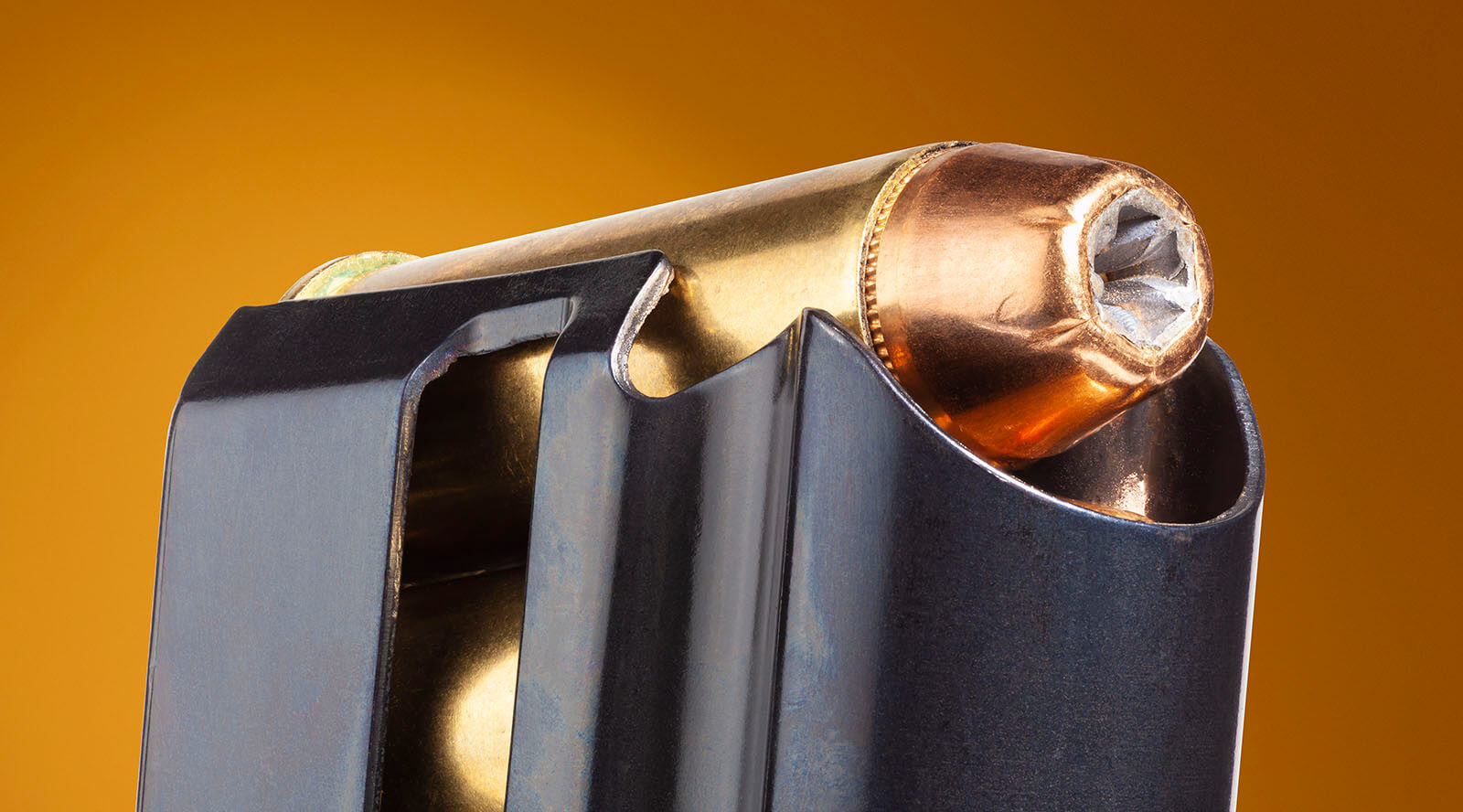When comparing practice ammunition with defensive ammunition you quickly notice the price difference. Double, even triple the cost is normal. The cost may influence your decision to select the cheaper practice ammunition for home defense or everyday carry. The difference in price is a result of a difference in performance—terminal performance to be exact. Terminal performance is the predicted behavior and effects of a projectile when it hits and transfers its energy to the target. You don’t need to be a ballistic expert to appreciate the benefits of defensive ammunition, but you do need a basic working knowledge of why to use hollow point bullets.
What is the best self-defense ammo? It will be ammunition that demonstrates these three attributes:
- Improved functioning and reliability
- Better penetration, but without overpenetration
- Predictable expansion and more damage
What are hollow points bullets? Often referenced as jacketed hollow point, or JHP, it is a type of ammunition most easily recognized by their hollow tip. The practice of using jacketed hollow points bullets to quickly stop an attack has been standard practice for decades. The operative word is quickly. We want the attack to stop as fast as possible. The longer the attack, the more likely we are to be injured or worse. Time is not on our side; we are already starting behind the power curve. The bad guy gets to pick the time and place for most attacks. We are left to react to their actions. The quicker I can stop the attack, the better the chances that my family, if present, and I survive unscathed. But how do I quickly stop an attack once it’s already started? Quick is also a subjective term in this case. Several seconds to the victim can seem like an eternity. However many rounds you fire, you want each one to do their job, and quickly.
Checking for Compatibility and Functioning
The loudest sound in a gunfight is a “click.” The sound made when the trigger is squeezed and nothing happens. It can happen for a couple of reasons. A common one is if you choose not to chamber a round and forget. You must remember to cycle the action to make the pistol ready to fire. I understand why some may choose this ready condition, but that is a subject for another article. If you do carry with a chambered round and you still get a click, now we enter the realm of reliability issues. The benefit of choosing premium defensive ammunition is improved quality control. This helps to ensure manufacture defects are identified well before the ammunition ends up in the hands of the consumer. With better quality control, we see less factory-related problems.
The condition of the pistol can be a contributing factor. If the firearm is dirty and/or dry it can cause the round to get stuck on the feed ramp or fail to full seat. Worn or broken recoil springs can lose their strength and produce stoppages, especially when the pistol is dirty and or dry. Routine cleaning, lubricating and maintenance can virtually eliminate this stoppage. Some pistols just don’t like hollow points. Luckily, the firearm’s industry recognized the importance of reliable feeding and functioning with premium defensive ammunition. Today’s modern firearms gobble up just about every make and model of premium hollow point ammunition. This still shouldn’t stop you from verifying on your own.
You need to test ammunition for reliable functioning in your carry or home defensive pistol. Firing a box of hollow point ammunition, or about 50 rounds, should help you to confirm reliability. It is also ideal to zero any pistol-mounted optic with your defensive ammunition to ensure point of aim/point of impact, thus killing two birds with one stone. Defensive ammunition can also run a little hotter or with more perceived recoil so getting familiar can help avoid any extra surprises. Part of this test is the magazine since it’s the last cog in this wheel. Magazines require little maintenance, but they can sometimes be the cause for the stoppage. The magazine is pushing the top round into proper alignment for chambering by a spring. If the spring weakens or foreign objects get into the body of the magazine, they can cause the follower to grind to a halt. You might be thinking how dirt, sand or even mud can get into the magazine. If you are practicing and run out of ammunition, you perform a reload to resume shooting, which means you typically drop the empty magazine. This is how you can find all that debris. Wiping them down with a dry rag and even disassembling for cleaning is not a bad idea. Just don’t oil the magazine, or any of its parts. Checking the reliability of all these moving parts ensures reliable functioning so you can hit the target.
Hitting and Reaching the Vital Anatomy
When it comes to the business side of this topic the most important consideration is that we hit the target. Everything I say from this point forward implies you hit the target because there is no making up for a miss, no matter how good the ammo. When the bullet hits the target a lot of things are happening. First—the bullet starts to slow down and the hollow cavity begins to fill. There is a dance that ammunition manufacturers perform. They must ensure the bullet slows down enough to stay in the body, but still fast enough to penetrate to the vital anatomy. The agreed upon minimum penetration depth is 12 inches. This may seem extreme, but the depth comes when hitting a target not perfectly square. In other words, either bladed or turned sideways. Now, you must also penetrate through the extremities such as the arms and still reach the vital anatomy. There is also clothing and layers to contend with that can negatively effect penetration depth. Some clothing such as denim and leather is tough and reduces the speed more so than lighter garments. Layers act in a similar capacity to slow down the projectile. It is this combination of angle and clothing that was used to create the 12-inch depth—an effort to factor in realistic scenarios to ensure the projectile has the best chance of reaching the vitals to stop the attack. Like anything, too much of a good thing can be bad.
While we don’t want the projectile to underpenetrate, we also don’t want it to overpenetrate. This is more common with the full metal jacket, or FMJ, practice ammunition—it makes a small entry and exit wound causing little damage compared to the optimal performance from premium jacketed hollow point ammunition. Overpenetration is a real concern in a justifiable defensive shooting. Should the round or rounds fired miss or overpenetrate, you are responsible for the terminal resting spot of each round fired. One of the four firearm safety rules is “know your target and what’s beyond.” If you miss or the round overpenetrates and innocent bystanders are in the backdrop, they are in the field of fire. Even if there are no innocent bystanders downrange, any damage caused by your projectiles is your responsibility. Ammunition manufacturers have been perfecting this combination over decades. Most premium hollow point rounds penetrate to at least 12 inches and stop at 18 inches. This gives us the best chance of penetrating deep enough to hit the vitals while reducing the risk of overpenetration. Velocity is not the only control measure to reduce overpenetration.
Creating A Larger Surface Area
Since we as humans are made up mostly of water, there are some unique forces at play once the projectile strikes the target—the hollow cavity begins to fill. As it does so, this fluid and matter works to create pressure exerted against the inside wall of the cavity. This in turn applies an outward force, peeling back the perforated core and jacket. Expansion accomplishes two tasks; it slows the projectile reducing overpenetration and creates a larger surface area, thereby increasing the damage potential. The science of bullet technology has advanced to the point reliable expansion is a normal expectation. The greater surface from expansion means more damage.
When a round penetrates the human body, it creates a wound channel. This wound channel is permanent and related to the amount of damage caused. The intention is to create enough damage to the body that vital life processes stop and therefore the attack stops. The bigger the wound channel, the more damage leading to the quicker stop. Well-designed JHP ammunition can expand to twice the original diameter. Not only does this create the potential for increased surface area and more damage, but the energy transfer is significant. FMJ rounds are not designed for either of these traits and one reason they are used as a last option for self-defense.
Defensive gun uses are more and more common, or they seem that way with the increase in closed-circuit television (CCTV) and social media. To answer the question if hollow point ammunition is good for self-defense, we can learn from these as well as having a better understanding of what hollow point ammunition does. We want ammunition that will fire each time. Premium JHP ammunition is manufactured and tested for higher quality control. Even then, it is incumbent on the user to test with the compatibility of the pistol, magazine and ammunition mixture. We want ammunition that will penetrate deep enough to reach the vital anatomy, but not so deep they overpenetrate. Reaching the vitals speeds the process of stopping the attack. What we don’t want is our rounds to miss or pass through the target potentially hitting a third party or causing permanent damage. Expansion helps to control overpenetration and increases the surface area and energy transfer. Thus, helping to stop the attack quicker with hopefully fewer rounds of fire. While not perfect, using premium self-defense ammunition creates better conditions to stop and survive an attack.


